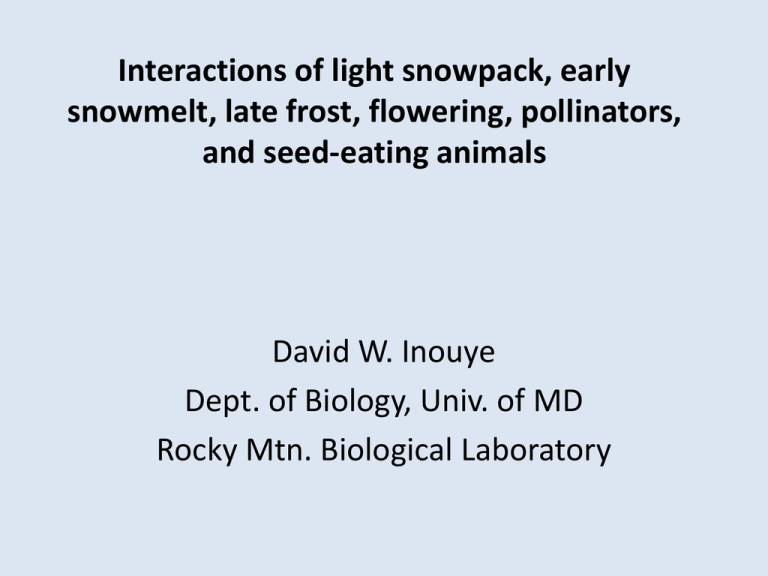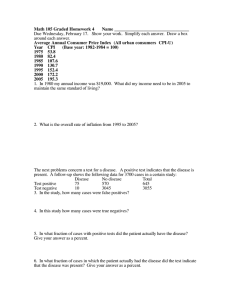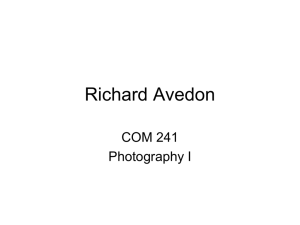Interactions of light snowpack, early snowmelt, late frost, flowering, pollinators,
advertisement

Interactions of light snowpack, early snowmelt, late frost, flowering, pollinators, and seed-eating animals David W. Inouye Dept. of Biology, Univ. of MD Rocky Mtn. Biological Laboratory Global climate Local climate Snowpack Snowmelt Regional climate NPO (50-75 yr) ENSO (2-7 yr) QBO (25.9 mo) Phenology of migration and Emergence Pollination Frost Effects Flowering Phenology Abundance Granivores Plant demography Nature 461, 481-484 (24 September 2009) | The North Pacific Oscillation Warm phase Cool phase http://tao.atmos.washington.edu/pdo/ Ratio of Snow to Rain, Gunnison (7,683') Annual ratio of snow to rain (inches) 10 6.22" precip 60.3" snow r2=.068 p = .039 8 6 4 12.05" precip 32.6" snow 2 1900 1920 1940 1960 1980 2000 Ratio of Snow to Rain, Aspen (7,913') Annual ratio of snow to rain (inches) 11 precip 16.11" snow 165.9" 10 r2 = .098 p = .052 9 8 7 6 5 precip 26.37" snow 125.2" 4 1940 1960 1980 2000 Crested Butte Annual precipitation (inches) 45 40 35 30 25 20 15 10 5 1920 1940 1960 1980 2000 Crested Butte Annual snowfall (inches) 400 350 r2=.165 p < .001 300 250 200 150 100 50 1920 1940 1960 1980 2000 Ratio of snow to rain, Crested Butte (8,950') Annual ratio of snow to rain (inches) 14 27.6" precipitation 349" snow 12 10 8 6 2 4 r = .093 p = .006 33.3" precipitation 87" snow 2 1920 1940 1960 1980 2000 " Changing Environment • Changes in temperature • Changes in precipitation • Increased variation • Changes can be global, regional, or local In short: • A changing ecological environment Changes in phenology (timing of seasonal events) The Rocky Mountain Biological Laboratory Mean snowfall (since 1975) = 11.0 m Range = 4.7 – 16.4 m 1800 Winter Snowfall in Gothic 1600 Snowfall (cm) 1400 1200 1000 800 600 400 200 0 1975 1980 1985 1990 1995 2000 2005 2010 Total winter snowfall in Gothic (cm) 1800 1600 1400 1200 1000 800 600 400 1975 1980 1985 1990 1995 2000 2005 2010 Total snowfall in Gothic (cm) 1800 2 1600 r = .159 p = .060 1400 1200 1000 800 600 400 1975 1980 1985 1990 1995 2000 2005 2010 billy barr at RMBL since 1972 First Date of Bare Ground (Day of Year) When does the snow melt? 180 Gothic Snow Data (from billy barr) 6/19/95 170 160 150 140 130 120 110 4/26/77 1975 1980 4/25/02 1985 1990 1995 2000 2005 4/23/12 2010 Gothic snowmelt First Day of Bare Ground (Day of Year) 180 170 160 150 140 130 120 110 100 1975 1980 1985 1990 1995 2000 2005 2010 Mean minimum April temperature (°F) 26 24 22 20 18 16 14 12 10 r2 = .193, p = .005 8 1975 1980 1985 1990 1995 2000 2005 2010 Day of year of peak flow, East River at Almont 29 June 180 170 160 150 140 130 7 May 120 1940 1960 1980 2000 Dust storm approaching Phoenix, AZ, July 5, 2011, photo by Daniel Bryant Phoenix, AZ http://www.wunderground.com/wximage/nitehawk/60 Was also forecast for: Montrose, CO Grand Junction, CO Gunnison, CO Aspen, CO Telluride, CO Rifle, CO Cahone, CO Dove Creek, CO Cisco, UT Thompson, UT Moab, UT Bluff, UT Mexican Water, AZ Global climate Regional climate NPO (50-75 yr) ENSO (2-7 yr) QBO (25.9 mo) Local climate Snowpack Snowmelt Flowering Phenology Abundance Frost Effects Frost can significantly reduce flower abundance 13 June 2001 21.55 (F) -5.81 (C) 11 June 2004 25.07° F 22F 6/11 Helianthella quinquenervis Number of aspen sunflower heads 3500 lower plot upper plot 3000 2500 2000 1500 1000 500 0 1976 1980 1984 1988 1992 1996 2000 2004 2008 2012 Number of unfrosted flower heads 5000 2008 1982 4000 2011 1995 1984 3000 1980 1983 1994 1999 1978 1997 1993 2009 1991 2000 1979 1975 1996 2006 2005 1998 1000 1977 2003 0 1987 2000 1990 1988 20021981 1989 2007 2010 2001 1976 1992 2004 110 20 April 120 130 140 1986 1985 150 Day of year of snowmelt 160 170 19 June Helianthella quinquenervis 1400 Maxfield plots Number of plants 1200 1000 800 600 400 200 0 1998 2000 2002 2004 2006 2008 2010 Delphinium barbeyi Delphinium barbeyi Tall larkspur Fruit Farmers in Northeast Brace for Frigid Temps • • By THE ASSOCIATED PRESS Published: April 27, 2012 at 3:05 PM ET • Farmers in the Northeast are preparing orchard heaters, irrigation systems and frost alarms to protect their fruit crops from temperatures that are expected to dip overnight to near freezing. • While the cold weather is fairly typical for late April, farmers say fruit crops are more vulnerable this season because they blossomed early as a result of a March warm spell. • Some farmers say the forecast for Friday night poses the biggest threat yet for crop damage. The National Weather Service has issued a freeze warning for parts of several New England states and much of New York and Pennsylvania. Gu, L., et al. 2008. The 2007 eastern US spring freeze: Increased cold damage in a warming world? BioScience 58:253-262. Global climate Regional climate NPO (PDO) ENSO Local climate Snowpack Snowmelt Frost Effects Flowering Phenology Abundance Species Interactions Plant Demography Asynchronous changes in phenology of migrating Broad-tailed Hummingbirds and their early-season nectar resources 180 DAY OF YEAR 170 160 150 140 130 120 1970 1980 1990 YEAR 2000 2010 2020 Day of year of first sighting 180 170 160 150 140 130 120 0 50 100 150 Snowpack on 30 April (cm) 200 Are insect pollinators being affected? Speyeria mormonia and Erigeron speciosus Maximum Number of Flowers Counted 2011 1800 1979 1600 1984 1400 1200 1983 1980 1982 2005 1000 800 1998 1999 1996 600 400 1981 200 0 2009 2004 2003 1992 1977 2007 2002 0 1988 2006 2010 2000 20011987 1976 1989 25 50 75 1995 1975 2008 1978 1993 1986 1991 1997 1974 19941985 100 125 150 175 Snowpack on 30 April (cm) 200 225 visits proportion rootroot Square proportionofvists square 1.0 X X female 0.9 X 0.8 male 0.7 0.6 0.5 X 0.4 0.3 X 0.2 0.1 0 500 1,000 # Erigeron flowers 1,500 Growth, Male Butterfly (Nt) year t+1 (Nt+1) - Ln LnPopulation 2 1 0 -1 -2 -2 -1 0 1 2 Ln (Flowers butterflies in year t) Ln/ #(flowers/Nt) 3 The Erigeron – Speyeria story • • • • • • Decreasing snowpack Warmer springs Earlier snowmelt Increased incidence of frost damage Fewer flowers (less nectar) for butterflies Fewer butterflies Boggs, C. L., and D. W. Inouye. 2012. A single climate driver has direct and indirect effects on pollinator numbers. Ecology Letters 15(5):502-508. Day of year of first bare ground in Gothic Calculated and observed dates of snowmelt 20 June 160 140 120 4/23 100 1940 1950 1960 1970 1980 1990 2000 2010 Number of Helianthella flowers 5000 observed calculated 4000 r2 = .552 3000 2000 1000 0 110 4/20 120 130 140 150 160 Day of year of snowmelt 170 6/19 Mertensia ciliata (Boraginaceae) Maximum number of flowers in bloom Mertensia ciliata 700 2 600 r = 0.334 p = .004 500 400 300 200 100 0 1975 1980 1985 1990 1995 2000 2005 2010 Mertensia ciliata Maximum number of flowers 700 1993 r2 = .330 p = .004 600 1997 1998 500 1984 1986 400 1992 1994 1995 19911999 1996 300 1985 1975 2000 1988 1987 1982 200 1979 1980 1983 100 1977 0 400 1981 600 1989 800 1000 1200 1400 Total snowfall in Gothic (cm) 1600 Mean day of year of first flower 205 Mertensia ciliata 2 r = 0.682 p < .001 200 1995 195 1975 1983 2008 190 1991 1999 185 1988 180 1984 1982 1979 1993 1978 2011 1980 1989 1997 2006 1986 2002 2009 2010 19871976 1998 19961985 1981 1992 2000 1977 2007 2004 2001 1994 2003 175 170 110 120 130 140 150 160 Day of year of first bare ground 170 170 Mean day of year of first flower r2 = .681 p < .001 Claytonia lanceolata 14 June 160 150 140 130 120 24 April 110 20 April 110 120 130 140 150 Day of year of bare ground 160 170 19 June 200 Date of first flower 190 180 170 160 Cardamine cordifolia 150 140 1970 1980 1990 2000 2010 Aldridge, G., D. W. Inouye, J. R. K. Forrest, W. A. Barr, and A. J. Miller-Rushing. 2011. Emergence of a mid-season period of low floral resources in a montane meadow ecosystem associated with climate change. Journal of Ecology 99(4): 905-913. Global climate Local climate Snowpack Snowmelt Regional climate NPO ENSO Phenology of migration and Emergence Pollination Frost Effects Flowering Phenology Abundance Plant Demography Chipmunk (Tamius minimus) Golden-mantled ground squirrels (Spermophilus lateralis) Yellow-bellied marmots (Marmota flaviventris) Day of year of first chipmunk sighting 12 May 130 120 110 100 7 April 1975 1980 1985 1990 1995 2000 2005 2010 Day of year of first chipmunk sighting 12 May 130 120 110 2 r = .173 p = .012 100 6 April 90 110 20 April 120 130 140 150 Day of year of snowmelt 160 170 19 June Day of year of first chipmunk sighting 135 r2 = .209 p = .009 130 125 120 115 110 105 100 95 26 28 30 32 34 36 Average April temperature (°F) 38 Date of first marmot sighting in Gothic 30 May 20 May 10 May 1 May 20 April 10 April 1 April 25 March r2 = .351 p < .001 1975 1980 1985 1990 1995 2000 2005 2010 Emergence day relative to marmot Chipmunk 50 2 r = .497 p < .0001 40 30 20 10 0 -10 -20 -30 1980 1990 2000 2010 Emergence day relative to marmot Ground squirrel 60 40 20 0 -20 -40 r2=.354 p < .001 -60 1980 1990 2000 2010 Day of first sighting or first flower 200 r2 = .157 p = .025 180 160 140 120 100 80 1970 1980 1990 2000 2010 Wyoming ground squirrel (Spermophilus elegans) – moving up valleys Foxes – moving up valleys Veratrum tenuipetalum (Melanthiaceae) Ramets flowering (of 1,000 counted) Is there an environmental cue that triggers Veratrum flowering? 600 500 East side plot 400 West side plot 300 * = watered 200 100 0 1985 1990 1995 * * 2000 2005 2010 log (% flowering) 2.0 1.6 1.2 0.8 0.4 0.0 12 13 14 15 16 o July temperature C) two years prior July(otemperature ( C)to flowering o July temperature ( C) 17 16 15 14 13 12 11 0 85 90 95 00 05 10 8 19 19 19 19 20 20 20 Year Is there an effect of climate change? Environmental conditions were conducive to flowering in 21.6% of the years from 1928-1983 compared to 14.8% from 1984 to 2010. Conclusions • • • • • • • The climate is changing Snowmelt dates are getting earlier Flowering is starting earlier Frequency of frost damage is increasing Plant demography is being affected Pollinators may be affected Variation in species responses may lead to altered and new interactions Global climate Local climate Snowpack Snowmelt Regional climate NPO ENSO Phenology of migration and Emergence Pollination Frost Effects Flowering Phenology Abundance Plant Demography “…. billions of dollars of stimulus funding have been wasted, mismanaged, or directed towards silly and shortsighted projects.” 35. Study of Wildflowers in a Ghost Town ($448,995) A few dilapidated buildings are largely what remains in Gothic, Colorado, a ghost town that is also home to the Rocky Mountain Biological Laboratory. Over the next five years, however, Gothic will host a $448,995 National Science Foundation study by Dr. David Inouye on the impact of climate change on the town's wildflowers. In recent years [they] have been reportedly impacted by late season frost that he believes is caused by global warming. According to the Denver Post, however, after a visit to the town this past spring, with the bounty of wildflowers filling the meadows and blooming in the crannies of Colorado's high country, you'd never guess that some of them are in trouble. Delphinium nuttallianum - 8 yr intervals Mean day of year of first flower 190 180 170 160 150 140 130 1975 1980 1985 1990 1995 2000 2005 2010



